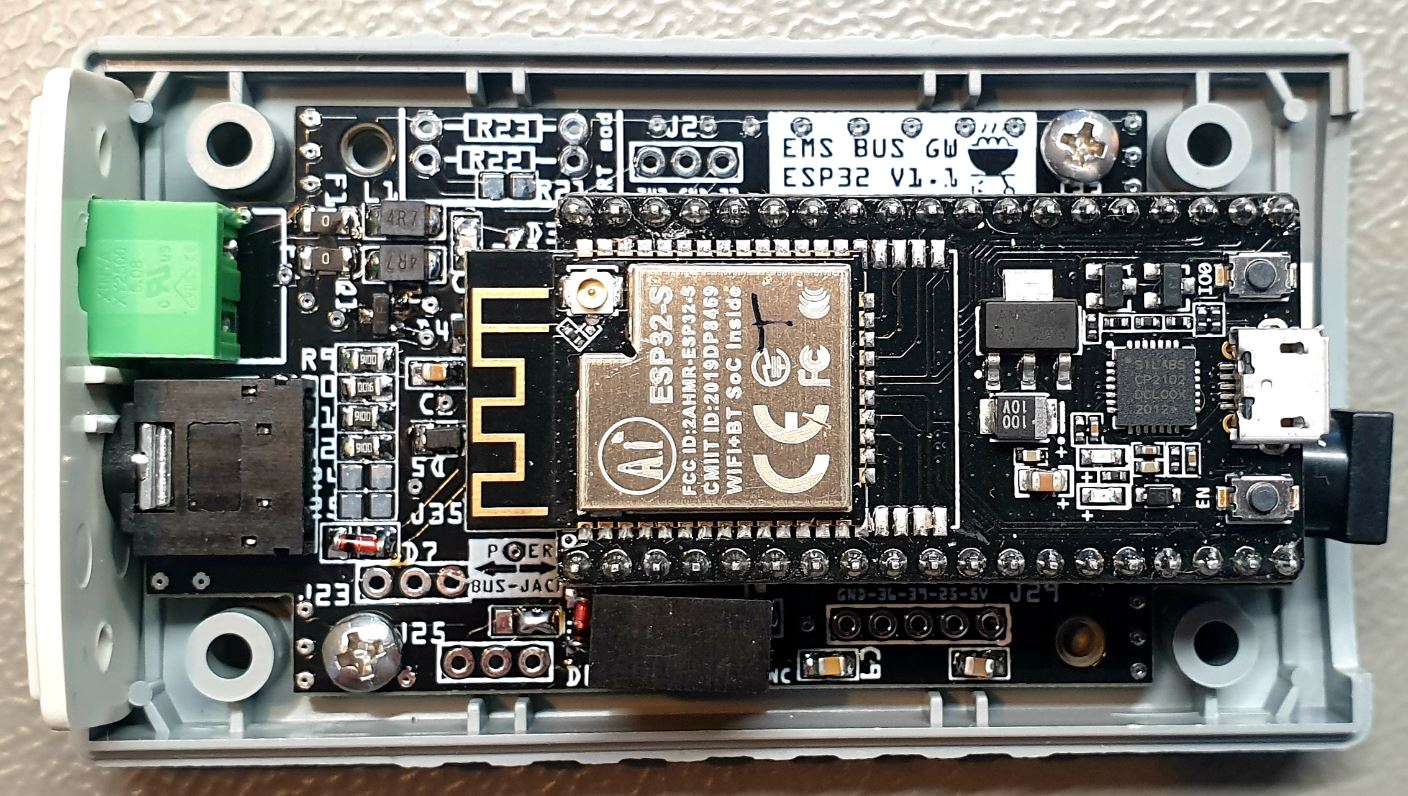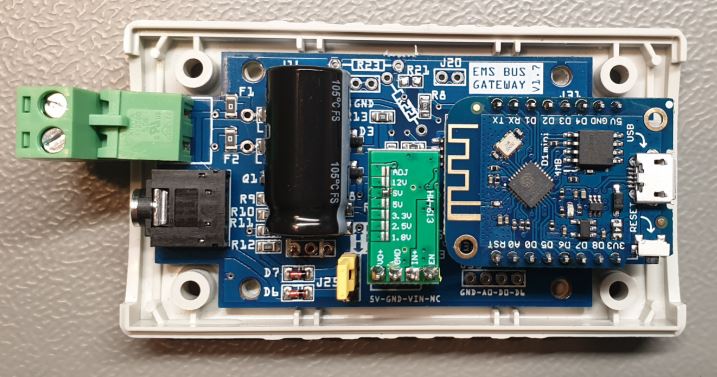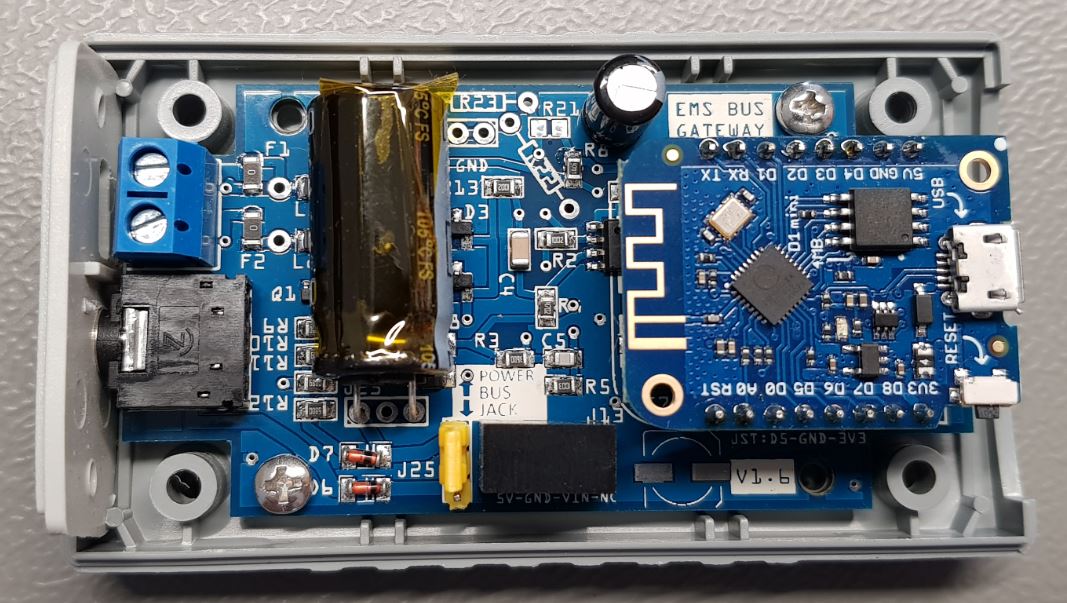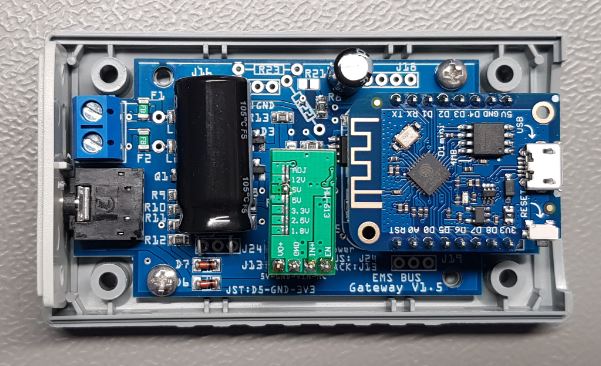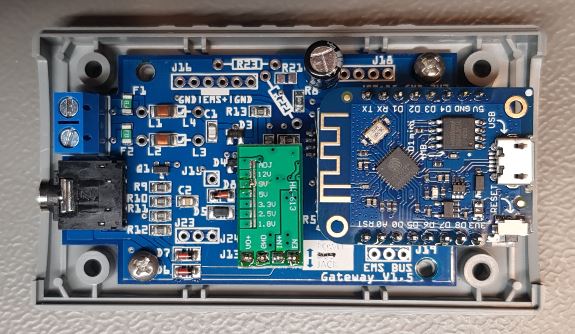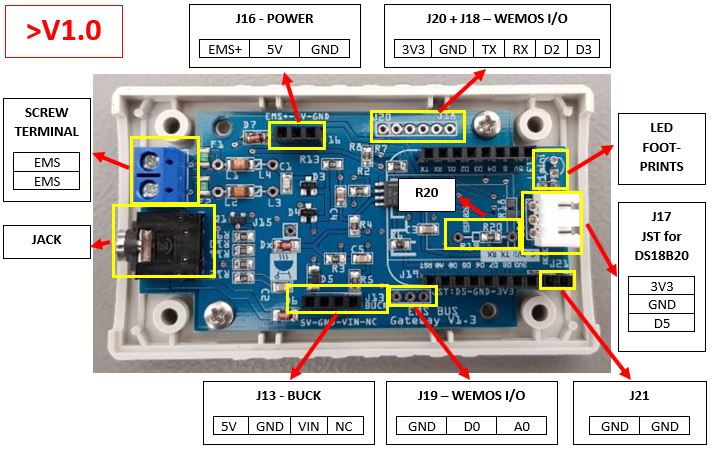Gateway hardware details¶
Each Gateway is a modular system consisting of a circuit board, a buck voltage regulator and a n ESP microcontroller board all inside an enclosure. Each Gateway edition is based on a particular circuit board version.
Gateway feature matrix¶
Gateway type |
Availability |
PCB version |
Jack power |
EMS Bus power |
USB power 2 |
Ethernet |
12V DC adapter |
ESP type |
ESP board |
USB chip |
|---|---|---|---|---|---|---|---|---|---|---|
E32 (ESP32 Ethernet edition) |
≥12-2021 |
1.5 |
Yes |
No |
No |
Yes |
Yes |
ESP32 |
ESP32 Eth |
CH340 |
E32 (ESP32 Ethernet edition) |
≥04-2021 |
1.0/1.3/1.4 |
Yes |
No |
No |
Yes |
Yes |
ESP32 |
ESP32 Eth |
CH340 |
S32 (ESP32 Standard edition) |
≥02-2021 |
1.1 |
Yes |
No |
Yes 3 |
No |
Yes |
ESP32 |
NodeMCU 32S |
CP2102 |
P2 (Premium II) |
≥01≤05-2021 |
1.7 |
Yes |
Yes |
Yes |
No |
No |
ESP8266 |
Lolin V3.1 |
CH340 |
Premium II |
≥12-2019 |
1.5/1.6 |
Yes |
Yes |
Yes |
No |
No |
ESP8266 |
Lolin V3.1 |
CH340 |
Standard |
≥12-2019 |
1.5 |
Yes |
No 1 |
Yes |
No |
No |
ESP8266 |
Lolin V3.1 |
CH340 |
Premium |
≥10≤12-2019 |
1.3 |
Yes |
No 1 |
Yes |
No |
No |
ESP8266 |
Lolin V3.1 |
CH340 |
Regular |
≥07≤12-2019 |
1.3 |
Yes |
No |
Yes |
No |
No |
ESP8266 |
clone V2 |
CH340 |
First version |
≥06≤07-2019 |
0.2 |
Yes |
No |
Yes |
No |
No |
ESP8266 |
clone V2 |
CH340 |
- 1(1,2)
If needed this board type can be converted to EMS power.
- 2
USB powered via optional USB adapter with micro USB connector.
- 3
USB power is possible, but not needed because there is a 12V DC adapter included
Tip
You can upgrade all ESP8266 based Gateways to an ESP32. See HERE.
Details on the current Gateway editions¶
Gateway board version ESP32 V1.5 (E32)¶
In December 2021 a minor revision of the ESP32 based Gateway model E32 (Ethernet edition) was introduced. It now has an internal USB port, CH340 USB chip and an on-board screw connector. There is no functional difference with the older revisions of the E32.
Gateway board version ESP32 V1.0/V1.3/V1.4 (E32)¶
In April 2021 the new ESP32 based Gateway model E32 (Ethernet edition) was introduced. It has the same features as the S32 model, but it also has a RJ45 Ethernet port. This model can be powered via the service jack or a 12V DC adapter. Because the ESP32 uses more power than the ESP8266 with EMS-ESP, parasitic bus power is not possible with this Gateway model. Additionally GPIO 32 is exposed on an internal header (together with GND and 3.3V) on the top next to the button. The EMS-ESP API has a function to turn this GPIO into LOW or HIGH state.
To make room for the Ethernet port, the screw terminal has been removed. With each E32 Gateway a screw terminal plug is included so you can connect to the EMS bus wires as well.
This model has an external CH340 USB programmer included (which you will likely never need).
There is no functional difference between revisions 1.0/1.3/1.4 of the E32, only a few minor adjustments in the ground plane and the PCB silkscreen.
Gateway board version ESP32 V1.1 (S32)¶
In March 2021 the new ESP32-based Gateway model S32 (Standard edition) was introduced. It keeps the same dimensions and EMS interface circuit as the ESP8266 V1.7 board. This model can be powered via the service jack or a 12V DC adapter. Because the ESP32 uses more power than the ESP8266 with EMS-ESP, parasitic bus power is not possible with this Gateway model.
On the Gateway board the Lolin D1 Mini has been upgraded to an original Ai-Thinker NodeMCU-32 dev board with a Silabs CP2102 USB to serial chip. To accomodate for the 5,5mm DC barrel jack the JST connector (for connecting optional Dallas temperature sensors) has been changed from a 2,5mm JST XH connector to a much smaller 1,5mm JST ZH connector. Additionally GPIO 22, 25, 36 and 39 are exposed on internal headers. The EMS-ESP API has a function to turn these GPIO pins into LOW or HIGH state.
